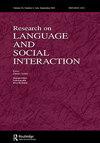点击时听不到说话
IF 2.1
1区 文学
Q1 COMMUNICATION
引用次数: 21
摘要
摘要本文探讨点击——一种非语言的发声方式——在日常谈话中的使用。有人认为,点击是不说话的一种方式,即在谈话到期时不发表谈话。虽然许多点击都发生在口头材料旁边,这为参与者提供了一种将动作归因于他们所处的回合的方法,但许多人并没有。本文探讨了参与者可以利用的语言(尤其是语音)、顺序和具体资源来理解这种点击。有人认为,某些点击具有语言组织的性质:它们具有非语言形式的意义映射。相比之下,其他点击更多地被解释为临时的、单一的事件。这篇文章对互动中的谈话提出了一种不那么以语源为中心的观点。数据来自音频和视频,分别为英国和美国英语。本文章由计算机程序翻译,如有差异,请以英文原文为准。
Audibly Not Saying Something with Clicks
ABSTRACT This article explores the use of clicks—a nonverbal vocalization—in everyday talk. It is argued that clicks are one way of not saying something, i.e., of not producing talk when talk was due. While many clicks occur alongside verbal material, which provides a method for participants to ascribe an action to the turn in which they are embedded, many do not. The article explores the linguistic (especially phonetic), sequential and embodied resources available to participants to make sense of such clicks. It is argued that some clicks have properties of linguistic organization: They have nonarbitrary form-meaning mappings. Other clicks by contrast are interpreted more as ad hoc, singular events. The article contributes to a less logocentric view of talk-in-interaction. Data are in British and American English from audio and video.
求助全文
通过发布文献求助,成功后即可免费获取论文全文。
去求助
来源期刊
CiteScore
7.30
自引率
7.40%
发文量
20
期刊介绍:
The journal publishes the highest quality empirical and theoretical research bearing on language as it is used in interaction. Researchers in communication, discourse analysis, conversation analysis, linguistic anthropology and ethnography are likely to be the most active contributors, but we welcome submission of articles from the broad range of interaction researchers. Published papers will normally involve the close analysis of naturally-occurring interaction. The journal is also open to theoretical essays, and to quantitative studies where these are tied closely to the results of naturalistic observation.

 求助内容:
求助内容: 应助结果提醒方式:
应助结果提醒方式:


